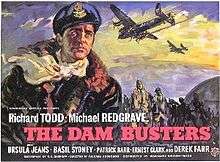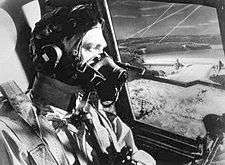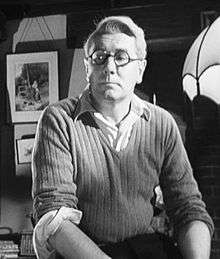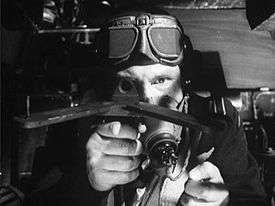The Dam Busters (film)
| The Dam Busters | |
|---|---|
 1955 British quad format film poster | |
| Directed by | Michael Anderson |
| Produced by |
Robert Clark W. A. Whittaker |
| Screenplay by | R. C. Sherriff |
| Based on |
The Dam Busters by Paul Brickhill Enemy Coast Ahead by Guy Gibson |
| Starring |
Richard Todd Michael Redgrave Ursula Jeans Basil Sydney |
| Music by |
Eric Coates Leighton Lucas |
| Cinematography |
Erwin Hillier Gilbert Taylor (Special Effects Photography) |
| Edited by | Richard Best |
Production company | |
| Distributed by | Ass. British Pathé (UK) |
Release dates |
|
Running time | 124 minutes |
| Country | United Kingdom |
| Language | English |
| Box office | £419,528 (UK)[1] |
The Dam Busters (1955) is a British Second World War war film starring Michael Redgrave and Richard Todd. It was directed by Michael Anderson. The film recreates the true story of Operation Chastise when in 1943 the RAF's 617 Squadron attacked the Möhne, Eder and Sorpe dams in Germany with Barnes Wallis's bouncing bomb.
The film was based on the books The Dam Busters (1951) by Paul Brickhill and Enemy Coast Ahead (1946) by Guy Gibson. The film's reflective last minutes convey the poignant mix of emotions felt by the characters – triumph over striking a successful blow against the enemy's industrial base is greatly tempered by the sobering knowledge that many died in the process of delivering it. A remake has reportedly been in development since 2008, but has yet to be produced as of 2016.
Plot
In the early years of the Second World War, aeronautical engineer Barnes Wallis is struggling to develop a means of attacking Germany's dams in the hope of crippling German heavy industry. Working for the Ministry of Aircraft Production, as well as doing his own job at Vickers, he works feverishly to make practical his theory of a bouncing bomb which would skip over the water to avoid protective torpedo nets. When it came into contact with the dam, it would sink before exploding, making it much more destructive. Wallis calculates that the aircraft will have to fly extremely low (150 feet (46 m)) to enable the bombs to skip over the water correctly, but when he takes his conclusions to the Ministry, he is told that lack of production capacity means they cannot go ahead with his proposals.
Angry and frustrated, Wallis secures an interview with Sir Arthur "Bomber" Harris (played by Basil Sydney), the head of RAF Bomber Command, who at first is reluctant to take the idea seriously. Eventually, however, he is convinced and takes the idea to the Prime Minister, who authorises the project.
Bomber Command forms a special squadron of Lancaster bombers, 617 Squadron, to be commanded by Wing Commander Guy Gibson, and tasked to fly the mission. He recruits experienced crews, especially those with low-altitude flight experience. While they train for the mission, Wallis continues his development of the bomb but has problems, such as the bomb breaking apart upon hitting the water. This requires the drop altitude to be reduced to 60 feet (18 m). With only a few weeks to go, he succeeds in fixing the problems and the mission can go ahead.
The bombers attack the dams. Eight Lancasters and their crews are lost, but the overall mission succeeds and two dams are breached.
Cast


In credits order.
- Richard Todd as Wing Commander Guy Gibson, CO of 617 Squadron and pilot of "George"
- Michael Redgrave as Barnes Wallis, Assistant Chief Designer, Aviation Section, Vickers-Armstrong Ltd
- Ursula Jeans as Mrs Molly Wallis
- Basil Sydney as Air Chief Marshal Sir Arthur Harris, GOC-in-C, RAF Bomber Command
- Patrick Barr as Captain Joseph "Mutt" Summers, Chief Test Pilot, Vickers-Armstrong Ltd
- Ernest Clark as Air Vice-Marshal Ralph Cochrane, AOC, No. 5 Group RAF
- Derek Farr as Group Captain John Whitworth, Station Commander, RAF Scampton
- Charles Carson as Doctor
- Stanley Van Beers as David Pye, Director of Scientific Research, Air Ministry
- Colin Tapley as Dr William Glanville, Director of Road Research, Department of Scientific and Industrial Research
- Frederick Leister as committee member
- Eric Messiter as committee member
- Laidman Browne as committee member
- Raymond Huntley as National Physical Laboratory Official
- Hugh Manning as Ministry of Aircraft Production Official
- Edwin Styles as Observer at Trials
- Hugh Moxey as Observer at Trials
- Anthony Shaw as RAF Officer at Trials
- Laurence Naismith as Farmer
- Harold Siddons as Group Signals Officer
- Frank Phillips as BBC Announcer
- Brewster Mason as Flight Lieutenant Richard Trevor-Roper, rear gunner of "George"
- Anthony Doonan as Flight Lieutenant Robert Hutchison, wireless operator of "George"
- Nigel Stock as Flying Officer Frederick Spafford, bomb aimer of "George"
- Brian Nissen as Flight Lieutenant Torger Taerum, navigator of "George"
- Robert Shaw as Flight Sergeant John Pulford, flight engineer of "George"
- Peter Assinder as Pilot Officer Andrew Deering, front gunner of "George"
- Richard Leech as Squadron Leader Melvin "Dinghy" Young, pilot of "Apple"
- Richard Thorp as Squadron Leader Henry Maudslay, pilot of "Zebra"
- John Fraser as Flight Lieutenant John Hopgood, pilot of "Mother"
- David Morrell as Flight Lieutenant Bill Astell, pilot of "Baker"
- Bill Kerr as Flight Lieutenant H. B. "Micky" Martin, pilot of "Popsie"
- George Baker as Flight Lieutenant David Maltby, pilot of "Johnny"
- Ronald Wilson as Flight Lieutenant Dave Shannon, pilot of "Leather"
- Denys Graham as Flying Officer Les Knight, pilot of "Nut"
- Basil Appleby as Flight Lieutenant Bob Hay, bomb aimer of "Popsie"
- Tim Turner as Flight Lieutenant Jack Leggo, navigator of "Popsie"
- Ewen Solon as Flight Sergeant G. E. Powell, crew chief
- Harold Goodwin as Gibson's Batman
- Peter Arne (uncredited) as Staff Officer to Air-Vice Marshal Cochrane
- Edward Cast (uncredited) as Crew Member
- Richard Coleman (uncredited) as RAF Officer
- Peter Diamond (uncredited) as Tail Gunner
- Gerald Harper (uncredited) as RAF Officer
- Arthur Howard (uncredited) as RAF Pay Clerk in NAAFI
- Lloyd Lamble (uncredited) as Collins
- Philip Latham (uncredited) as Flight Sergeant
- Patrick McGoohan (uncredited) as RAF Guard [N 1]
- Edwin Richfield (uncredited) as RAF Officer
- Elisabeth Gaunt (Barnes Wallis's daughter in real life) as photographer in the test tank[2]
Development
Robert Clark of ABPC bought the film rights to Brickhill's RAF-approved book in 1951 as a vehicle for Richard Todd. Just prior to the film's scheduled release, Guy Gibson's widow Eve took legal action to prevent it, and Brickhill and Clark were mired in months of wrangling with her until references to her husband's book Enemy Coast Ahead were included. Clark hired R.C. Sheriff to write a script based on a treatment by Brickhill which focused on the dams raid and excluded the later 617 Squadron operations covered in the book.[3] Further work on the script was done by Walter Mycroft.[4]
Production
The flight sequences of the film were shot using real Avro Lancaster bombers supplied by the RAF. The aircraft, four of the final production B.VIIs, had to be taken out of storage and specially modified by removing the mid-upper gun turrets to mimic 617 Squadron's special aircraft, and cost £130 per hour to run, which amounted to a tenth of the film's costs. A number of Avro Lincoln bombers were also used as "set dressing."[5] (An American cut was made more dramatic by depicting an aircraft flying into a hill and exploding. This version used stock footage from Warner Brothers of a Boeing B-17 Flying Fortress, not a Lancaster.)
The Upper Derwent Valley in Derbyshire (the test area for the real raids) doubled as the Ruhr valley for the film. The scene where the Dutch coast is crossed was filmed between Boston, Lincolnshire and King's Lynn, Norfolk, and other coastal scenes near Skegness. Additional aerial footage was shot above Windermere, in the Lake District.

While RAF Scampton, where the real raid launched, was used for some scenes, the principal airfield used for ground location shooting was RAF Hemswell, a few miles north and still an operational RAF station at the time of filming. Guy Gibson had been based at Hemswell in his final posting and the airfield had been an operational Avro Lancaster base during the war. At the time filming took place it was then home to No. 109 Squadron and No. 139 Squadron RAF, which were both operating English Electric Canberras on electronic countermeasures and nuclear air sampling missions over hydrogen bomb test sites in the Pacific and Australia. However, part of the RAF's fleet of ageing Avro Lincolns had been mothballed at Hemswell prior to being broken up and several of these static aircraft appeared in background shots during filming, doubling for additional No 617 Squadron Lancasters. The station headquarters building still stands on what is now an industrial estate and is named Gibson House. The four wartime hangars also still stand, little changed in external appearance since the war.
Serving RAF pilots from both squadrons based at Hemswell took turns flying the Lancasters during filming and found the close formation and low level flying around Derwentwater and Windermere exhilarating and a welcome change from their normal high level solo Canberra sorties.
Three of the four Lancaster bombers used in the film had also appeared in the Dirk Bogarde film Appointment in London two years earlier.[6]
Historical accuracy

The film is accurate historically with only a few minor exceptions – theatrical adaptation – mostly derived from Paul Brickhill's book, which itself was written when much detail about the raid was not yet in the public domain:
- Barnes Wallis said that he never encountered any opposition from bureaucracy. In the film, when a reluctant official asks what he can possibly say to the RAF to persuade them to lend a Vickers Wellington bomber for flight testing the bomb, Wallis suggests: "Well, if you told them that I designed it, do you think that might help?" Barnes Wallis was heavily involved with the design of the Wellington, as it used his geodesic construction method, but he was not the chief designer.
- Instead of all of Gibson's tour-expired crew at 106 Squadron volunteering to follow him to his new command, only his wireless operator, Hutchinson, went with him to 617 Squadron.
- Rather than the purpose as well as the method of the raid being Wallis' sole idea, the dams had already been identified as an important target by the Air Ministry before the war.
- Gibson did not devise the spotlights altimeter after visiting a theatre; it was suggested by Benjamin Lockspeiser of the Ministry of Aircraft Production after Gibson requested they solve the problem. It was a proven method used by RAF Coastal Command aircraft for some time.[7]
- The wooden coat hanger bomb sight intended to enable crews to release the weapon at the right distance from the target was not wholly successful; some crews used it, but others came up with their own solutions, such as pieces of string in the bomb-aimer's position and/or markings on the blister.
- No bomber flew into a hillside near a target on the actual raid. This scene, which is not in the original version, was included in the copy released on the North American market (see above). Three bombers are brought down by enemy fire and two crashed due to hitting power lines in the valleys.[8]
- Some of the sequences showing the testing of Upkeep in the film are of Mosquito fighter-bombers dropping the naval version of the bouncing bomb, code-named Highball, intended to be used against ships. This version of the weapon was never used operationally.
- At the time the film was made, certain aspects of Upkeep were still held classified, so the actual test footage was censored to hide any details of the test bombs (a black dot was superimposed over the bomb on each frame) and the dummy bombs carried by the Lancasters were almost spherical but with flat sides rather than the true cylindrical shape.
- The dummy bomb did not show the mechanism which created the back spin.
- Ammunition being loaded into Lancaster via Righthand side door the aircraft is .50 cal. M2 for Browning M2 heavy machine guns, not the .303 calibre machine guns found on the Lancaster in 1943.
- The attack on the Eder Dam clearly shows footage of a castle resembling Schloss Waldeck on the wrong side of the lake and dam during the attack. The position and angle of the lake in conjunction to the castle in reality obviously proves that the precise bombing-run would have needed a downhill approach to the west of the castle to line up the aircraft in heading, altitude, speed and distance in time before being able to release the weapon precisely on target.
- Wallis stated that his idea came from Nelson's bouncing cannonballs into the sides of enemy ships. (He also stated that Nelson sank one ship during the Battle of the Nile with a yorker, a cricket term for a ball that bounces under the bat, making it difficult to play.) No evidence of the truth of this is available. In a 1942 paper, Wallis mentioned the bouncing of cannonballs in the 16th and 17th centuries, but Nelson was not mentioned.[9]
The Dam Busters March
The main theme music, The Dam Busters March by Eric Coates, is for many synonymous with the film, as well as with the exploit itself. As a reminder of British success, it remains a favourite military band item at flypasts and can be heard at football games during England matches. One version released featured dialogue extracts from the film (specifically, the bombing run scene).
Reception
The film was the most popular film at the British box office in 1955.[10] As of May 2014, The Dam Busters currently holds 100% maximum approval rating on Rotten Tomatoes, indicating universal acclaim. At the same time, the film holds a four and a half star rating (7.2/10) on IMDb.
Remake
Work on a remake of The Dam Busters, produced by Peter Jackson and directed by first time director Christian Rivers, began in 2008. Jackson said in the mid-1990s that he became interested in remaking the 1955 film, but found that the rights had been bought by Mel Gibson. In 2004, Jackson was contacted by his agent, who said Gibson had dropped the rights. In December 2005, the rights were purchased by David Frost, from the Brickhill family.[11] Stephen Fry wrote the script.[12]
In March 2007, it was announced it will be distributed by Universal Pictures, and StudioCanal.[13] Filming was planned to commence in early 2009, on a budget of USD 40 million,[14] although no project specific filming had begun by May 2009.[15] The project was delayed because Jackson decided to make The Hobbit.
Weta Workshop was making the models and special effects for the film and had made 10 life size Lancaster bombers.[16] Fry said Wing Commander Guy Gibson's dog "Nigger" will be called "Digger" in the remake avoid controversy despite the historical inaccuracy.[17] Les Munro, a pilot in the strike team, joined the production crew in Masterton as technical advisor. Jackson was also to use newly declassified War Office documents to ensure the authenticity of the film.[18]
After Munro died in August 2015, Phil Bonner of the Lincolnshire Aviation Heritage Centre said he still thinks Jackson will eventually make the film, citing Jackson's passion for aviation. Jackson said, "There is only a limited span I can abide, of people driving me nuts asking me when I’m going to do that project. So I’ll have to do it. I want to, actually, it’s one of the truly great true stories of the Second World War, a wonderful, wonderful story."[19]
Influence
- The attack on the Death Star in the climax of the film Star Wars is a deliberate and acknowledged homage to the climactic sequence of The Dam Busters. In the former film, rebel pilots have to fly through a trench while evading enemy fire and fire a proton torpedo at a precise distance from the target to destroy the entire base with a single explosion; if one run fails, another run must be made by a different pilot. In addition to the similarity of the scenes, some of the dialogue is nearly identical. Star Wars also ends with an Elgarian-style march, like The Dam Busters.[20] The same may be said of 633 Squadron, in which a squadron of de Havilland Mosquitos must drop a bomb on a rock overhanging a key German factory at the end of a Norwegian fjord.[21]
- In the 1982 film Pink Floyd The Wall, scenes from The Dam Busters can be seen and heard playing on a television set several times during the film.
- The 1984 video game The Dam Busters was partially based on the film.
- Two television advertisements were made for a brand of beer, Carling Black Label, which played on the theme of The Dam Busters. Both were made before the English football team broke a 35-year losing streak against Germany. The first showed a German guard on top of a dam catching a bouncing bomb as if he were a goalkeeper. The second showed a British tourist throwing a Union Flag towel which skipped off the water like a bouncing bomb to reserve a pool-side seat before the German tourists could reserve them with their towels. Both actions were followed by the comment "I bet he drinks Carling Black Label".[22]
- In 1999, British television network ITV broadcast a censored version of the film, removing all utterances of "Nigger" (the real name of the unit's mascot, a black labrador). ITV blamed regional broadcaster London Weekend Television, which in turn alleged that a junior staff member had been responsible for the unauthorised cuts. When ITV again showed a censored version in June 2001, it was condemned by the Index on Censorship as "unnecessary and ridiculous" and because the edits introduced continuity errors.[23]
- In 2004, the magazine Total Film named The Dam Busters the 43rd greatest British film of all time. Although it has been praised as one of the greatest war films of all time it focuses on the technicalities of destroying the enemy's dams, rather than the enemy himself. The film does not attempt to gloss over the losses sustained amongst the airmen nor the devastation caused by the flooding of the enemy countryside.
- The British Channel 4 screened the censored American version in July 2007, in which the dialogue was dubbed so as to call the dog "Trigger", this screening took place just after the planned remake was announced. For the remake, Peter Jackson has said no decision has been made on the dog's name, but is in a "no-win, damned-if-you-do-and-damned-if-you-don't scenario", as changing the name could be seen as too much political correctness, while not changing the name could offend people.[24] Further, executive producer Sir David Frost was quoted in The Independent as stating: "Guy sometimes used to call his dog Nigsy, so I think that's what we will call it. Stephen has been coming up with other names, but this is the one I want."[25][N 2] In September 2007, as part of the BBC Summer of British Film series, The Dam Busters was shown at selected cinemas across the UK in its uncut format. The original, uncensored, version was also shown on 1 and 5 January 2013, by the British broadcaster Channel 5. It was the version, distributed by Studio Canal, containing shots of the bomber flying into a hill.
- On 16 May 2008, a commemoration of the 65th anniversary was held at Derwent Reservoir, including a flypast by a Lancaster, Spitfire and Hurricane. The event was attended by actor Richard Todd, representing the film crew and Les Munro, the last surviving pilot from the original raid, as well as Mary Stopes-Roe, the elder daughter of Sir Barnes Wallis.
References
Notes
- ↑ This was McGoohan's feature film debut, playing a guard posted outside a briefing room where the crews are being told of their mission. His only lines are spoken to Gibson's dog.
- ↑ Stephen Fry, the screenwriter, said there was "no question in America that you could ever have a dog called the N-word". In the remake, the dog will be called "Digger".[26]
Citations
- ↑ Porter, Vincent. "The Robert Clark Account." Historical Journal of Film, Radio and Television, Vol. 20, No 4, 2000.
- ↑ http://www.bbc.co.uk/iplayer/episode/b06j66l4/the-one-show-22102015
- ↑ Dando-Collins, Stephen, The Hero-Maker: A Biography of Paul Brickhill, 2016, Sydney, Penguin Random House, pp 290-295.
- ↑ British Cinema of the 1950s: The Decline of Deference By Sue Harper, Vincent Porter p 82-83
- ↑ Garbettt and Goulding 1971, pp. 142–143.
- ↑ " 'Appointment in London' (film)". imdb.com, 2009. Retrieved: 4 December 2009.
- ↑ "National Archives reveals inglorious truth behind classic World War Two movies." culture24.org.uk, 2 September 2009. Retrieved: 23 December 2009.
- ↑ http://www.pbs.org/wgbh/nova/military/bombing-hitler-dams.html
- ↑ Murray, Iain. Bouncing-Bomb Man: The Science of Sir Barnes Wallis. Sparkford, UK: Haynes, 2009. ISBN 978-1-84425-588-7.
- ↑ "'The Dam Busters'." Times [London, England], 29 December 1955, p. 12 via The Times Digital Archive. Retrieved: 11 July 2012.
- ↑ Conlon, Tara. "Frost clears Dam Busters for take-off." guardian.co.uk, 8 December 2005. Retrieved: 4 December 2009.
- ↑ Oatts, Joanne. "Fry denies 'Doctor Who' rumours." Digital Spy, 15 March 2007. Retrieved: 21 March 2007.
- ↑ "Who you gonna call? The Dam Busters." W Weta Holics. Retrieved: 21 March 2007.
- ↑ Cardy, Tom and Andrew Kelly. "Dambusters filming set for next year." The Dominion Post, 1 January 2008. Retrieved: 30 June 2008.
- ↑ Katterns, Tanya. "Takeoff Looms For Dam Film." The Dominion Post, 5 May 2009. Retrieved: 4 December 2009.
- ↑ "Weta Workshop Vehicles." wetanz.com, 2008. Retrieved: 4 December 2009.
- ↑ Cardy, Tom. "Dambusters dog bone of contention." stuff.co.nz, 13 June 2011. Retrieved: 20 May 2013.
- ↑ Bromhead, Peter. "Stars bow to hero of missions impossible." nzherald.co.nz, 11 October 2009. Retrieved: 4 December 2009.
- ↑ "The Dam Busters: Will Peter Jackson's remake of the iconic film ever get off the ground?", by Paul Gallagher, The Independent
- ↑ Ramsden, John. "The Dam Busters." google.com. Retrieved: 7 March 2009.
- ↑ Kaminski 2007, p. 90.
- ↑ Glancey, Jonathan. "Bombs away." guardian.co.uk, 6 May 2003. Retrieved: 4 December 2009.
- ↑ Milmo, Dan. "ITV attacked over Dam Busters censorship." The Guardian, 11 June 2001. Retrieved: 4 December 2009.
- ↑ Stax. "Jackson Talks Dam Busters." IGN, 6 September 2006. Retrieved: 21 March 2007.
- ↑ Marks, Kathy. "Nigsy? Trigger? N-word dilemma bounces on for Dam Busters II." The Independent, 6 May 2009. Retrieved: 15 May 2009.
- ↑ "Dam Busters dog renamed for movie remake." BBC, 10 June 2011.
Bibliography
- Dando-Collins, Stephen. The Hero Maker: A Biography of Paul Brickhill. Sydney, Penguin Random House, 2016. ISBN 978-0-85798-812-6.
- Dolan, Edward F. Jr. Hollywood Goes to War. London: Bison Books, 1985. ISBN 0-86124-229-7.
- Garbett, Mike and Brian Goulding. The Lancaster at War. Toronto: Musson Book Company, 1971. ISBN 0-7737-0005-6.
- Kaminski, Michael. The Secret History of Star Wars. Kingston, Ontario, Canada: Legacy Books Press, 2008, First edition 2007. ISBN 978-0-9784652-3-0.
External links
- The Dam Busters at the Internet Movie Database
- The Dam Busters at the TCM Movie Database
- The Dam Busters at AllMovie
- May 2003 article in The Guardian revisiting the actual sites of the film, and testifying to the iconic status of The Dam Busters March
- "The Dam-Busters" a 1954 Flight article on the making of the film
- "A Triumphant British Picture" a 1955 Flight review of The Dam Busters film by Bill Gunston